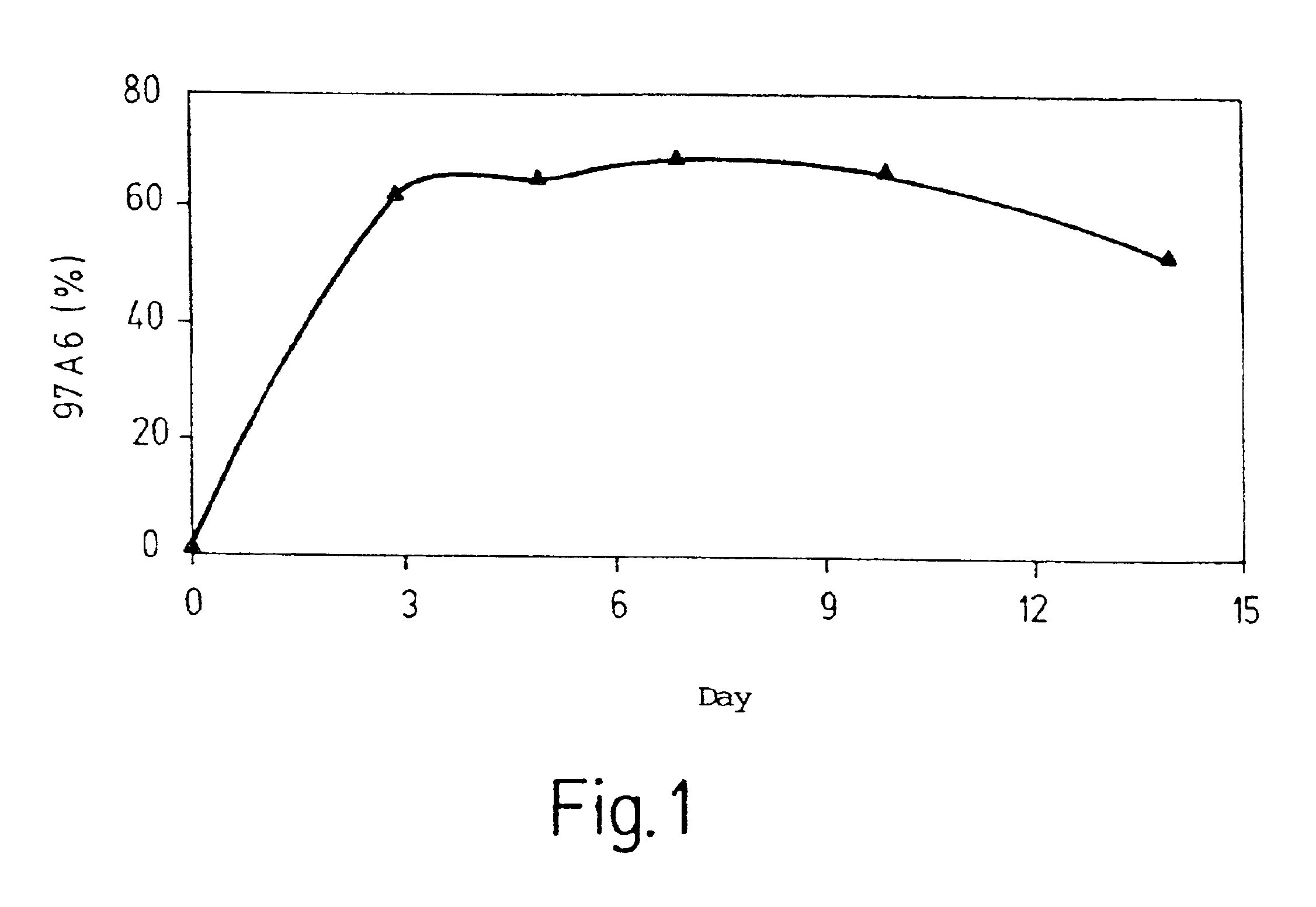Method for binding basophils and mast cells
a basophil and mast cell technology, applied in the field of basophil and mast cell binding methods, can solve the problems of not being able to recognize basophils and mast cells simultaneously, and no antibody is known to date, and achieve the effects of facilitating analysis of basophil differentiation, reducing the number of mast cells, and increasing sample throughpu
- Summary
- Abstract
- Description
- Claims
- Application Information
AI Technical Summary
Benefits of technology
Problems solved by technology
Method used
Image
Examples
example 1
[0076]Isolation and detection of basophils from peripheral blood of normal subjects and leukemia patients
[0077]It is known that the number of basophils in the peripheral blood of patients with CML rises with the transition from the chronic to the accelerated phase.
[0078]In order to test the specificity of antibody 97A6 for basophils, mononuclear leukocytes were separated, using Ficoll Hypaque, from other constituents of Buffy Coats from the peripheral blood of normal subjects or patients with CML in the acceleration phase. The interphase cells were then incubated with biotin-labeled antibody 97A6, washed three times, and incubated with anti-IgG MACSbeads (Miltenyi, Bergisch Gladbach, Germany). 97A6-positive cells were then isolated by MACS and then, for preparation monitoring purposes, labeled with phycoerythrin-labeled (PE-labeled) streptavidin and a PE-labeled 97A6 antibody, and analyzed in a flow cytometer.
[0079]The purity of the 97A6-positive cells was 99%.
[0080]For morphologica...
example 2
[0082]Detection of Tissue Mast Cells Using Antibody 97A6
[0083]Lung, foreskin, or uterine tissue was minced, washed in a buffer with 200 mg / l KCl, 50 mg / l NaH2PO4×H2O, 8 g / l NaCl, and 1 g / l glucose, and then incubated for 90 to 180 minutes at 37 ° C. with 2 mg / ml collagenase type II (Sebak, Suben, Austria). The dispersed cells were then centrifuged, washed, and incubated for 30 minutes with human AB serum. After being washed again, the cells were incubated for 30 minutes at 4° C. with antibody 97A6, washed, and then incubated for 30 minutes at 4° C. with a fluorescein-labeled goat F(ab′)2 IgG anti-mouse antibody. The cells were fixed for 1 minute in 0.025% glutaraldehyde, washed, and incubated for 8-12 minutes with 0.0125% toluidine blue. After washing, toluidine blue-stained mast cells were identified by their morphology using a fluorescence microscope (Olympus, Vienna, Austria) in brightfield mode, and then examined by fluorescent light.
[0084]It was found that only mast cells from ...
example 3
Isolation and Cultivation of Precursor Cells
[0085]Cells from bone marrow samples were centrifuged on Ficoll Hypaque that had a density of 1.077 g / cm3. The interphase cells were isolated, and cells that were positive for CD34 (a marker for hematopoietic precursor cells) were isolated using MACS. These cells were incubated with a FITC-labeled antibody against CD34 and with PE-labeled antibody 97A6. Doubly positive cells were selected by FACS and seeded in a semi-solid ready-made medium containing 0.9% methyl cellulose and a mixture of growth factors including IL-3 (a differentiation factor for basophils and eosinophils) (CellSystems, Remagen, Germany).
[0086]After incubation for 16 days at 37° C. in a humidified atmosphere (5% CO2), the resulting colonies were counted, transferred with a Pasteur pipette onto microscope slides, and stained with May-Grünwald-Giesma for morphological examination. In addition to the predominating pure basophil colonies, this examination also revealed mixed...
PUM
| Property | Measurement | Unit |
|---|---|---|
| density | aaaaa | aaaaa |
| concentration | aaaaa | aaaaa |
| fluorescent | aaaaa | aaaaa |
Abstract
Description
Claims
Application Information
 Login to View More
Login to View More - R&D
- Intellectual Property
- Life Sciences
- Materials
- Tech Scout
- Unparalleled Data Quality
- Higher Quality Content
- 60% Fewer Hallucinations
Browse by: Latest US Patents, China's latest patents, Technical Efficacy Thesaurus, Application Domain, Technology Topic, Popular Technical Reports.
© 2025 PatSnap. All rights reserved.Legal|Privacy policy|Modern Slavery Act Transparency Statement|Sitemap|About US| Contact US: help@patsnap.com



